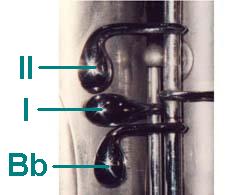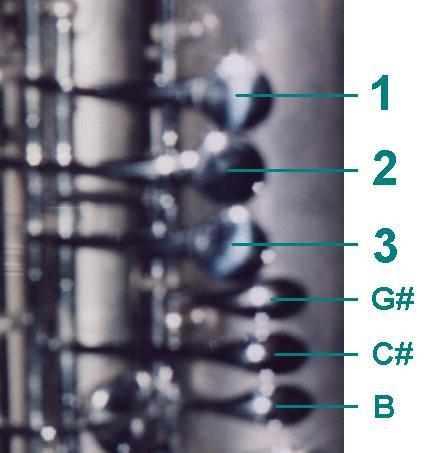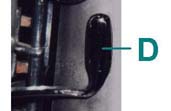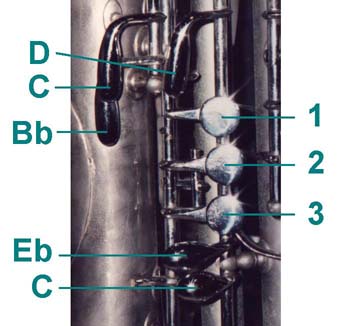Left
Thumb KeysI
· Low Octave Key
The high octave key is the thumb key that is closest
to the mouthpiece. The key is used as a vent for notes in the range D5
to G5 and E6 to G6. II
· High Octave Key
The low octave key is the middle thumb key, between
the second octave key and the low Bb key. The key is used as a vent for
notes in the range G#5 to D6. Bb
· Low Bb Key
The low Bb key is the key farthest from the mouthpiece.
The key is used primarily for playing low Bb3.
Left
Hand Main Keys1
· First (Index) Finger Key 2
· Second (Middle) Finger Key 3
· Third (Ring) Finger Key
Left
Hand Little Finger (Pinky) KeysG#
· G# Key
The G# key is located closer to the mouthpiece than the low C#
and low B keys and is used primarily for playing G#4, G#5,
and Eb6. C#
· Low C# Key
The low C# key is the outer key in this key stack and is
used primarily for playing low C#4. B
· Low B Key
The low B key is the inner key in this key stack and is used
primarily for playing low B3.
Right
Thumb KeysD
· D Octave key
The D octave key is the only right hand thumb key and is
used for playing D5, Eb5, and D6. On some
models, this key is placed as a left thumb key instead of a right thumb key.
Right
Hand Main Keys1
· First (Index) Finger Key 2
· Second (Middle) Finger Key 3
· Third (Ring) Finger Key
Right
Hand Side KeysD
· D Side Key
The D side key is the side key just above the right hand
main keys and is used to play third-octave D6. C
· C Side Key
The C side key is the side key closest to the mouthpiece
and is used as an alternate and trill fingering for first- and second-octave C.
Bb
· Bb Side Key
The side Bb key is the side key farthest from the mouthpiece
and is used for the basic and trill fingering for first- and second-octave Bb.
Right
Hand Little Finger (Pinky) KeysEb
· Low Eb Key
The low Eb key is the upper right hand little finger key
and is used for playing first- and second-octave Eb. Some models include rollers
for this key and the low C key for switching between the two keys. C
· Low C Key
The low C key is the lower right hand little finger key and
is used primarily for playing low C.
Sarrusophone
FingeringsThe
numbers 1, 2,
and 3 are used to represent
main holes to be closed while a dash (-)
is used to indicate a main hole to remain open. Left thumb keys are shown
first, followed by left hand main keys, a pipe (|)
to separate hands, and finally right hand main keys. II
123|1--
-2-|D 1-- Side
keys and little finger (pinky) keys are shown as superscripts in the left hand
and subscripts in the right hand at the position the keys are located. 12-|Bb---
123C#|123C
| 




